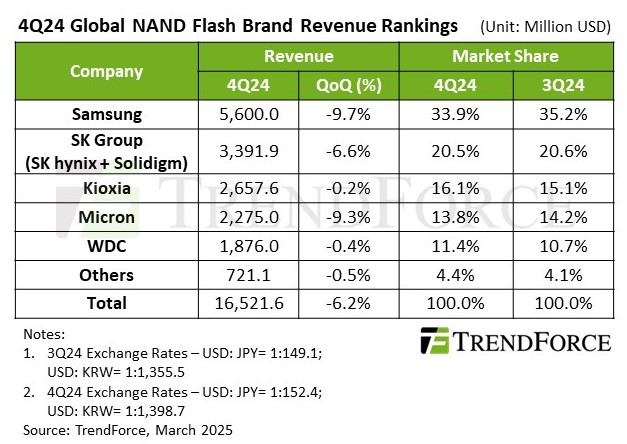The NAND market faced a 6.2% revenue loss in Q4 24 — forecast projects a further 20% hit in Q1 25

The latest TrendForce report suggests a 6.2% decline in NAND flash revenue across Q4 last year, primarily driven by weak consumer demand. Leading NAND flash manufacturers have faced a consistent revenue drop, with most focusing on enterprise to recoup losses. Considering the shifting market trends, ASPs (Average Selling Prices) and overall NAND flash shipments also took a minor hit.
TrendForce cites weakening consumer demand as the driving force behind this downturn. By the end of 2024, PC and smartphone manufacturers are reportedly being pushed to clear excess inventory, driving down NAND flash prices as a knock-on effect. ASPs (Average Selling Prices) for NAND flash dropped by 4% QoQ with a 2% decline in overall shipments. This trend is expected to persist for the first fiscal quarter this year, with TrendForce projecting a massive 20% industry-wide drop in revenue.
The global NAND flash revenue for Q4 2024 has been quoted at $16.52 billion, 6.2% lower than the previous quarter. A report that surfaced last October already foreshadowed this downturn. Memory producers were reportedly mulling over converting their existing NAND production facilities to focus on DRAM or HBM, which might've improved profits. All said and done, we should see an improvement by Q2 this year as production aligns with demand.

The report provided a chart comparing the industry-leading NAND flash providers. It seems that all manufacturers took marginal hits. That's quite telling, given how the same giants have been posting record profits in the HBM landscape. Samsung still holds 35.2% of the market, though it suffered a near 10% drop in revenue versus Q3 last year. The SK Group is in second place, with a 6.6% hit, followed by Kioxia at 0.2%, Micron at 9.3%, and WDC at 0.4%.
Most manufacturers are shifting gears to enterprise SSDs, per the report. Both Samsung and SK hynix suffered from production imbalances relative to market demand. Kioxia is taking a more technological stance with faster data transfer speeds and improving 3D NAND layer counts, as was reflected with its 10th-gen 332-layer V-NAND flash recently. Micron reportedly plans to cut back on costs in NAND flash operations but will continue offering high-capacity enterprise SSDs to boost earnings.
Get Tom's Hardware's best news and in-depth reviews, straight to your inbox.

Hassam Nasir is a die-hard hardware enthusiast with years of experience as a tech editor and writer, focusing on detailed CPU comparisons and general hardware news. When he’s not working, you’ll find him bending tubes for his ever-evolving custom water-loop gaming rig or benchmarking the latest CPUs and GPUs just for fun.
-
George³ Wait a minute, why are they blaming us consumers and not the greedy prices, which should have become more affordable long ago, and the capacity should have moved up to 16TB, or more. After all, everyone is profiting from supercomputers for "AI" training, the bubble, and consumers are left in a dead end.Reply -
Stomx Exactly. I have screenshot somewhere from Dec 2023 with the prices for 4TB NVMe SSD around $160 which you can not find anywhere even todayReply -
AkroZ Several previous quarters have an insane grow of 26% to 30% by quarter. Losing 10% in this quarter is not so troublesome.Reply
NAND market is tied to the PC market, as all tied markets in PC have serious inflated prices, notably in GPU but also in storage, the consumer is waiting for the market to stabilize.
Conclusion: prices are too high, -
thesyndrome The logical thing to do would be to lower prices to clear stock and engender good will among consumers.Reply
Instead they are looking to move to HBM in the enterprise sector to chase the dragon of 'constantly increasing profits year over year', which is a mad concept.